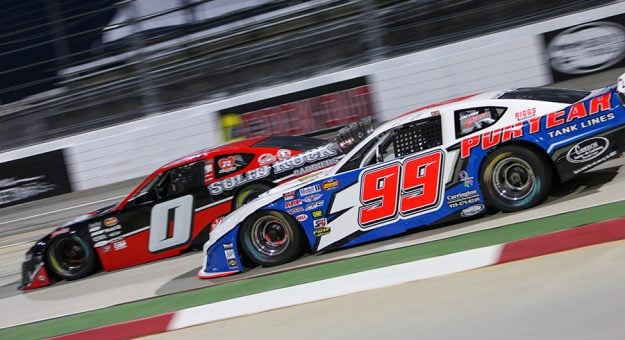To many, the asphalt super late models and the late model stock cars found at race tracks throughout the Southeast look nearly identical.
However, looks can be deceiving.
Super late models and late model stock cars are vastly different, from the engines in the cars to the styles of chassis that each race car utilizes. From straightaway speed to cornering, each style of race car has its own unique components that make it different.
To better understand the differences under the hood, SPEED SPORT spoke with Jeremy Upchurch of Upchurch Performance. Upchurch Performance supplies engines to many of the top asphalt late model teams in the country.
In fact, one of Upchurch’s engines powered Chandler Smith to victory during the 54th Snowball Derby at Florida’s Five Flags Speedway in December.
On the chassis and setup side, we consulted with the namesake of Lee Faulk Racing and Development. Faulk has been involved in the motorsports industry for 50 years and is intimately familiar with super late models and late model stock cars.
Horsepower
There is a significant difference in horsepower for super late models and late model stock cars.
According to Upchurch, a typical super late model engine creates approximately 630 horsepower. A late model stock car engine, on the other hand, generally makes around 510 horsepower.
Of course, the differences don’t stop there. According to Upchurch, super late model engines are purpose-built for racing.
“These are purpose-built V-8 engines. None of the parts in the engine you would find on a factory car,” Upchurch said. “Not the cylinder blocks, the heads, none of the parts. They’re similarly designed parts, but all of them are aftermarket parts.”
Depending on which engine builder a racer buys from, a typical super late model engine costs between $25,000 and $30,000.
“The engines are pretty involved,” Upchurch explained. “It’s a lot of labor because they’re custom-built engines.”
Late model stock car engines are quite a bit different.
Racers who wish to build a Chevrolet late model stock car engine are required to purchase the parts from Harrington’s Machine Shop in Taylorsville, N.C. Those parts, which cost roughly $10,000, can then be taken to any engine builder who will assemble the engine.
All of the parts that are sold to each race team to build a Chevrolet late model stock car engine are the same, the only difference is the engine builder. As a result, teams pay different labor costs for different builders.
For teams wishing to use Ford late model stock car engines, the process is slightly different, as the parts are available from multiple vendors.
However, those parts are required to be the same regardless of which vendor the race team acquires them from. According to Upchurch, neither engine has a significant advantage, though, the Ford engine could cost slightly more.
“They both make 510 or 515 horsepower, right in that range,” Upchurch said. “Longevity is the same, they weigh the same.”
According to Upchurch, the initial goal was for late model stock car competitors to only be able to choose between those two engines.
However, as race tracks struggled with car counts, some race tracks expanded their rules packages to allow for different engine combinations. Upchurch explained one such option.
“Some tracks weren’t getting cars, so they started opening up to different things,” Upchurch said. “Late model stock used to have a more expensive engine that you could run. It didn’t make as much power as these engines, but it was a more expensive engine.
“Some people still had those, and they were able to run them in limited (late model) and other classes. So they would open it up to that engine, but let the car be a lighter weight because it didn’t make as much power.”
Upchurch explained that anytime someone asks him to build a late model stock car engine, he has to review rules packages at whatever track the team plans to race, so he can make sure he builds them an engine that will be as competitive as possible based on the track’s rules.
“I have this conversation once a week, somebody calls me up and says, ‘I want an engine to run at Kingsport, Tenn.,’” Upchurch said. “Well, I’ve got to look the rules up to see what I think is the most advantageous engine to run because it’s different than what you would run at Florence, S.C., or it’s different than what you would run at South Boston, or it’s different weight combinations.”
In short, if you’re going to race a late model stock car at a track in the Southeast on any given weekend, check the rulebook.
Click below to continue reading.
